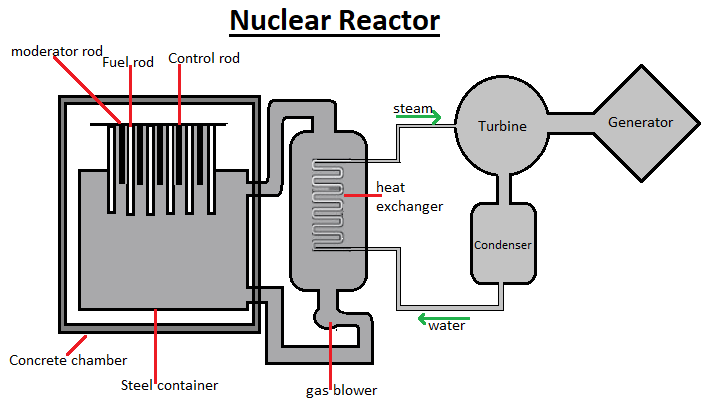
Draw a diagram of nuclear power reactor and label the parts
Answer
566.1k+ views
Hint: A nuclear reactor is a device that controls the chain nuclear reaction. In a nuclear reactor heat is produced inside the reactor due to the process of fission. This heat is converted into electricity.
Complete answer:

The labeled diagram of a nuclear reactor is given above.
In a nuclear reactor, firstly we have a concrete chamber inside the chamber we have a steel vessel. It is inside this steel vessel where the nuclear reaction actually takes place.
Then we have the fuel rods inside it. These rods are the fissionable materials used for the reactions. Generally we use uranium-235 (${}^{235}\text{U}$), plutonium, thorium etc.
In between the fuel rods we have the control rods. They are generally made of cadmium. They are used to control the nuclear reactions.
When the reaction takes place a large amount of heat is produced. Thus heat is transferred to the heat exchanger by means of a pump. Inside the heat exchanger we have liquid sodium as coolant. The heat exchanger is again connected to the steel vessel.
The high pressure steam from the heat exchanger is passed on to the turbine. Turbine is a mechanical component which is coupled to the generator. When the high pressure steam reaches the turbine, the turbine rotates due to the high pressure.
Due to the rotation of the turbine the generator will produce electricity.
The steam from the turbine should be converted back into water, so that it can be reused for the reaction. For that the steam from the turbine is passed on to a condenser. The condenser converts the steam into water.
Then by means of a pump the water is pumped back into the heat exchanger.
Note:
Inside a nuclear reactor the heat produced by nuclear reaction is converted into electricity by the means of a generator.
The main components of a nuclear reactor are:
Fuel: the fissionable material used in the reaction.
Moderator: to decrease the speed of the fast moving neutrons formed during the fission.
Control rods: used to control the reaction or to stop the chain reaction.
Coolant: to absorb the heat produced by fission.
Turbine: the turbine rotates due to the heat. Therefore the heat energy is converted into mechanical energy in a turbine.
Generator: it converts the mechanical energy into electrical energy.
Complete answer:

The labeled diagram of a nuclear reactor is given above.
In a nuclear reactor, firstly we have a concrete chamber inside the chamber we have a steel vessel. It is inside this steel vessel where the nuclear reaction actually takes place.
Then we have the fuel rods inside it. These rods are the fissionable materials used for the reactions. Generally we use uranium-235 (${}^{235}\text{U}$), plutonium, thorium etc.
In between the fuel rods we have the control rods. They are generally made of cadmium. They are used to control the nuclear reactions.
When the reaction takes place a large amount of heat is produced. Thus heat is transferred to the heat exchanger by means of a pump. Inside the heat exchanger we have liquid sodium as coolant. The heat exchanger is again connected to the steel vessel.
The high pressure steam from the heat exchanger is passed on to the turbine. Turbine is a mechanical component which is coupled to the generator. When the high pressure steam reaches the turbine, the turbine rotates due to the high pressure.
Due to the rotation of the turbine the generator will produce electricity.
The steam from the turbine should be converted back into water, so that it can be reused for the reaction. For that the steam from the turbine is passed on to a condenser. The condenser converts the steam into water.
Then by means of a pump the water is pumped back into the heat exchanger.
Note:
Inside a nuclear reactor the heat produced by nuclear reaction is converted into electricity by the means of a generator.
The main components of a nuclear reactor are:
Fuel: the fissionable material used in the reaction.
Moderator: to decrease the speed of the fast moving neutrons formed during the fission.
Control rods: used to control the reaction or to stop the chain reaction.
Coolant: to absorb the heat produced by fission.
Turbine: the turbine rotates due to the heat. Therefore the heat energy is converted into mechanical energy in a turbine.
Generator: it converts the mechanical energy into electrical energy.
Recently Updated Pages
Master Class 12 English: Engaging Questions & Answers for Success

Master Class 12 Social Science: Engaging Questions & Answers for Success

Master Class 12 Chemistry: Engaging Questions & Answers for Success

Which is the Longest Railway Platform in the world?

India Manned Space Mission Launch Target Month and Year 2025 Update

Which of the following pairs is correct?

Trending doubts
What are the major means of transport Explain each class 12 social science CBSE

Which are the Top 10 Largest Countries of the World?

Draw a labelled sketch of the human eye class 12 physics CBSE

How much time does it take to bleed after eating p class 12 biology CBSE

Explain sex determination in humans with line diag class 12 biology CBSE

Plot a graph between potential difference V and current class 12 physics CBSE




